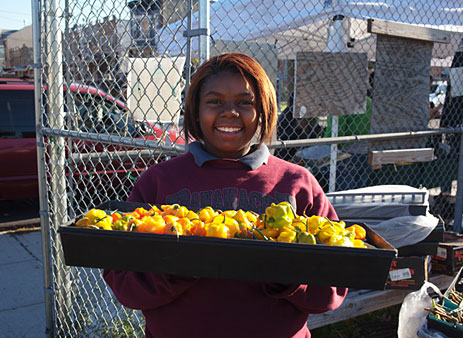 The smarter lunchroom. Click to go to the Times’ interactive version.Rendering: Brian Wansink, David Just, Joe McKendry/NY TimesWith the opportunity to “go big” on reforming school lunch slipping away, the latest push appears to be to “go small.”
The smarter lunchroom. Click to go to the Times’ interactive version.Rendering: Brian Wansink, David Just, Joe McKendry/NY TimesWith the opportunity to “go big” on reforming school lunch slipping away, the latest push appears to be to “go small.”
Researchers David Just and Brian Wansink of the Cornell Center for Behavioral Economics in Child Nutrition Programs are pushing a set of “nudge-y” ideas out of behavioral economics to reform the lunchroom and get kids to eat the healthy food that reform-minded school food directors are serving. because, as they wrote for The Atlantic‘s website, “Food isn’t nutritious until it is eaten.”
They also recently published an instructive infographic on The New York Times website that demonstrates the different possibilities a “smart cafeteria” could offer. (Click the graphic to see the full, interactive version at the Times.)
Just and Wansink observe that:
Restaurant owners know that subtle changes in how food is presented can have a large impact on food choice. These same tools can be applied within the school lunch context with surprising results. One school in upstate New York was able to increase consumption of salads by close to 300 percent by simply moving their salad bar six feet from the wall and placing it near a natural bottleneck in the check-out line. Another school increased fruit sales by 105 percent by moving the apples and oranges from stainless steel bins into a well-lit and attractive basket.
Even better, these techniques don’t require much in the way of new training, new recipes — or new money.
I’d like to think that the food revolution only needs to rearrange the lunchline, rather than our priorities as a nation (see France). Maybe so.
But let’s not lose sight of the stakes. New research has given the lie to the myth of the “fit but fat” child. Obese children can have normal blood pressure and even normal cholesterol and yet, when given echo-cardiograms, show clear signs of heart disease. Specifically, Canadian doctors discovered that obese children display “stiffening” of the aorta — a symptom of heart disease typically seen in middle-aged men rather than middle-school kids. As one of the scientists in the study put it, dryly but chillingly, “Aortic stiffness is associated with cardiovascular events and early death.”
It’s enough to make me think Michelle Obama should rename her Let’s Move initiative to “Let’s Move … Or Else.”




